|
You may
recall Mellrichstadt, that last small town on the B19 before
either taking the left on to 285 towards Ostheim and
Fladungen or the right to the farm roads and then east into
the fields for the OPs near Muhlfeld
 and Rossreith. Keep
going straight, first Eussenhausen and then the trail to OP
Sierra / Tennessee; drive for only a few more Kilometers,
road signs for Meiningen and if that was the case, you had
clearly gone too far. For thousands of troopers en route to
the border, Mellrichstadt was really a drive - through town
but in 1949, it was the main destination for a group of
American humanitarians from central Minnesota. and Rossreith. Keep
going straight, first Eussenhausen and then the trail to OP
Sierra / Tennessee; drive for only a few more Kilometers,
road signs for Meiningen and if that was the case, you had
clearly gone too far. For thousands of troopers en route to
the border, Mellrichstadt was really a drive - through town
but in 1949, it was the main destination for a group of
American humanitarians from central Minnesota.
Anton
Volkmuth - An Interested Party
Anton “ Tony
“ Volkmuth had immigrated from the village of Oberstreu,
just south of Mellrichstadt, to the United States in 1921
and listed his occupation as a brick layer. Once in
Minnesota, and after a winter of cutting ice, he took a job
first as a “ printer’s devil “ and then as a printer at the
German language newspaper, Der Nordstern and later with the
Saint Cloud Times. By 1938, he started his own weekly
publication, The Saint Cloud News, later renamed, the Thrift
News. Through the war years, the paper gradually increased
circulation and became a central Minnesota success. In
1948, desperately interested in the plight of his former
home, he returned as a tourist to Germany and was deeply
disturbed by what he saw.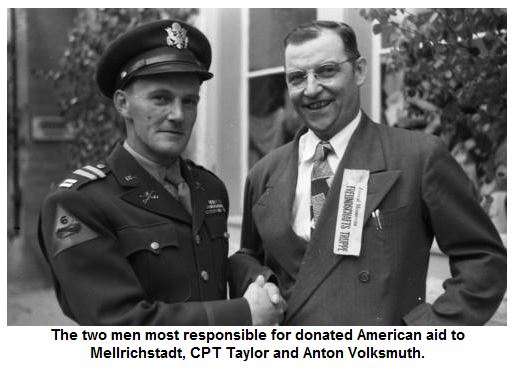
Starvation
had been averted but the best intentions of rebuilding the
German economy in rural Northern Bavaria had met with only
marginal success. Seemingly every other town had an
orphanage that could barely cope with abandoned children,
basic consumer goods were hardly available or priced on the
black market well above the means of the local farmers, shop
keepers and villagers. American occupation and then
Constabulary troops were sensitive to what they saw but had
few assets beyond sympathy with which to act.
Upon return
to Saint Cloud, and when not running the newspaper, Volkmuth
devoted his energies to local public speaking on the plight
of post war Germany and in particular, the privations found
in the region of his former home town. This found a
sympathetic ear among the thousands of Minnesotans of German
heritage and an ad hoc relief effort began which culminated
with Christmas 1948. This was particularly good timing,
Congress had only just authorized US private aid to Germany.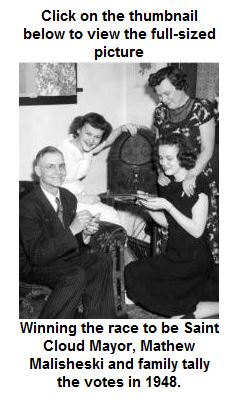
Although
there are no records of a meeting, clearly Volkmuth, during
his recent visit, would have met Army Lieutenant Clayton
Miles Taylor and his wife, the only two Americans stationed
in Mellrichstadt and later, they would have corresponded
regularly as to local conditions. Taylor was a highly
decorated combat veteran who fought in the 6th Armor
Division tank destroyer battalion during the war. Fluent in
German and placed in the high visibility position of
American Military Governor in the Rhoen region, he was
charged with guiding this part of post war Germany towards
democracy, including monitoring day to day life and
politics in the town and surrounding villages.
Lt “ Bud “
Taylor was appalled by conditions he found, and in
particular, how aid often seemed to miss the Protestant
minority in Bavaria. Under his administration, he was
determined to see a fair and equable distribution of the
private gifts pouring in from America.
An article in
Stars and Stripes, late December 1948, recounting American
Christmas charitable activities mentioned that Lt. Taylor
had organized local parties and events for over 2500
children with gifts and donations originating from Saint
Cloud, Minnesota. Volkmuth was certainly very active in the
1948 charity drive however, those efforts were largely
unheralded. What is clear is that by early 1949, he now
publicly had become very much the point man for central
Minnesota charitable contributions destined for
Mellrichstadt.
A pious
Catholic who knew the local church powers, Volkmuth also
knew the recently elected Saint Cloud Mayor, Mathew
Malisheski, and it did not take long to organize a renewed
post Christmas aid drive. Tony used his weekly paper to
billboard the activities.
Between the
newspaper, the pulpit and city hall, soon donations of
clothing, basic necessities and even money came pouring into
the now officially named Operation Democracy. A local
woman, Madeline Savig, who was also a regional Girl Scout
executive, found space to store the donations at the local
Red Cross center and plenty of labor, her Scouts, to sort
and box what arrived, an estimated seven tons of clothing
with a total value of all the collections in excess of
$100,000. By February 1949, the packages began to flow to
Germany. Mayor Malisheski proclaimed Mellrichstadt and
Saint Cloud to be sister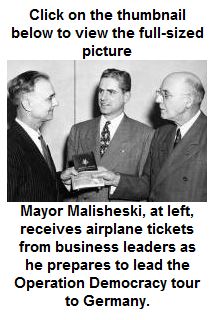 cities. cities.
How the
distribution worked in Germany is somewhat unclear although
the Office of Military Government was certainly involved.
Mellrichstadt served as the hub with aid going throughout
the surrounding region ultimately reaching some 35,000
people. The newly promoted Captain Taylor had left his
position, replaced by an American civilian, Ellis H. McKay
and his government team probably provided supervision and
some support to grateful local Germany authorities. The
role of the teams was never designed to be truly hands on,
but rather, to oversee the process as local Germans worked
to find solutions to problems and at the same time, remained
free of Communist influence.
In a letter
to the Saint Cloud Times on March 3 1949, McKay, stated ,
“ inhabitants of the local area regard the average citizens
of Saint Cloud to be a cross between Santa Claus and General
George C. Marshall. “ Along with McKay’s letter came a
number of thank - you letters from local Germans who had
already received aid parcels.
Mathew
Malisheski - A Traveling Man
Mathew
Malisheski was elected Mayor of Saint Cloud in 1948 in an
election that saw a little over six thousand ballets cast.
The forty - nine year old was a long time labor activist
with the Brotherhood of Railway Carmen of America and
employee of the Great Northern Railroad. He was a man of
some ambition and, once in office, had a vision that reached
well beyond the prairies.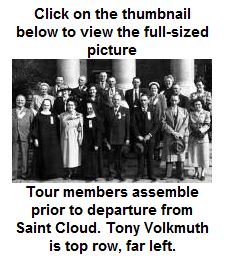
Amid the
background of Tony Volkmuth’s fund raising, in mid
February 1949, Saint Cloud newspapers reported that
Mayor Malisheski would lead a group of local interested
citizens to Europe on a fact finding and good will
tour. The tour would feature the Mayor visiting Saint
Cloud , France, Mellrichstadt and then on to Rome and an
audience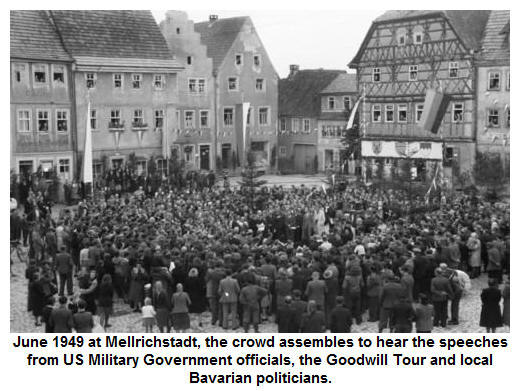 with the Pope. The excursion to France was in
response to a visit one year earlier by the Mayor of
their sister - city and namesake found just outside of
Paris. with the Pope. The excursion to France was in
response to a visit one year earlier by the Mayor of
their sister - city and namesake found just outside of
Paris.
The
opportunity to get Germans and Americans together for a
grand photo opportunity in the spirit of post war charity
was too much for any man to resist and Mayor Malisheski
certainly saw the possibilities. Interestingly, Volkmuth
recedes in the local newspaper coverage at this point
perhaps due to the surviving microfilm rolls from that
period were those of competing Saint Cloud newspapers.
Malisheski, on the other hand, is consistently mentioned in
the lead paragraphs.
Over in
Germany, Stars and Strips reported that Volkmuth was
instrumental in designing the itinerary for the “ Minnesota
Goodwill Tour “, a caravan that not only would visit central
Germany but also Switzerland and Rome. The plan was to
arrive in Frankfurt and then make the journey to
Mellrichstadt for a few days to see first hand the plight of
the recipients of the American charity. Then, side trips
through southern Germany and elsewhere in Europe for those
who could afford the journey with certain members of the
party reuniting at Mellrichstadt prior to final departure.
When the
aircraft took off from Minneapolis on 30 May 1949, the tour
had 23 people including Volkmuth, Mayor Malisheski and a
host of personal friends, acquaintances and contributors.
Most had paid their own way and had family scattered across
Bavaria. The Mayor’s tickets were funded by local
businessmen. It was reported that the group was the largest
such mission to leave Minnesota in the post war period. Of
note, almost every member of the group could speak German
and had earlier shipped food to Mellrichstadt to insure
that their visit would place no undo burdens on the local
civilians. The papers reported that due to customs
regulations, the five married couples in the group had to
carefully account for the candy, cigars and clothing brought
as gifts which could not exceed $50.00 in total value.
On Tour, 1949
1 June 1949,
Stars and Stripes reported the arrival of the tour and their
impressions of visits to Displaced Persons camps and sites
where aid was distributed to Germans. Apparently they were
shocked at what they found; Mrs. Savig summed it up, “ We
need to keep the supplies coming!”
On the same
day, local Minnesota papers reported more extensively on the
caravan as it reached Mellrichstadt. Military Government
dignitaries, McKay and his boss, Sidney C. White, US
Director of Military Government for Northern Bavaria spoke
as did regional German officials including Werner May, the
local German government representative. The blurry
photographs on the microfilm rolls witness the town square
filled with people, Mayor Malisheski and Werner May front
and center.
Following the
remarks, Mayor Malisheski was presented with an official
certificate of appreciation and a hand painted commemorative
bowl. The archives of the German Main Post contained
several photographs from that day showing the tour thru the
town, dignitaries, as well as visits to families that
received American charity.
A German -
American friendship banquet was held that night followed by
a dance. Malisheski was quoted, “ he hoped the visit would
impress the German people with the need for democratic
principles in government. “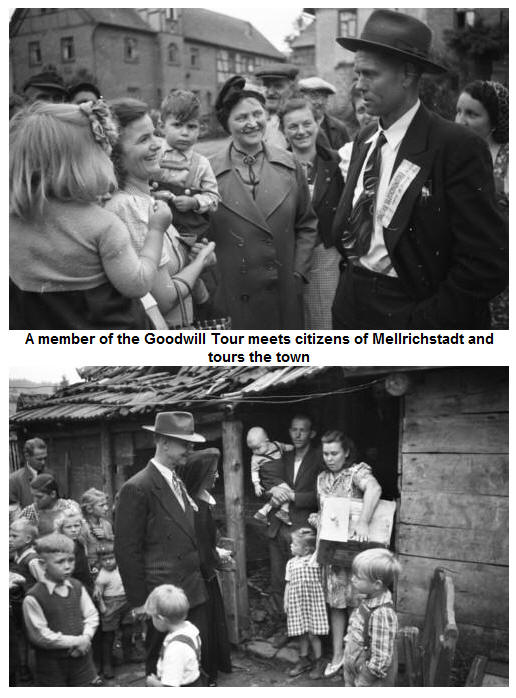
Stars and
Stripes on June 8 feature a brief article on the tour group
recalling the background of the trip and stating that
despite some improvements in living conditions for local
Germans, the conditions found at one orphanage in particular
were appalling and the charity drive should certainly
continue.
In mid June,
a flurry of reports detailed the visit of the Mayor and a
few other caravan members to Paris and Saint Cloud. They
were honored as participants in a ceremony dedicated to
French General LeClerc and the following day, the party was
in Rome for an audience with the Pope. With this, the
official good will caravan ended and the participants went
their separate ways, some returning to the United States and
others traveling individually in Europe.
Ellis McKay
wrote a lengthy letter in early September to the Saint Cloud
Daily Times expressing his thanks for not only the material
goods provided by the charity drive and the visit that
Summer but, more importantly, the bonds of friendship
between Germany and America that had been so strongly
reinforced. He noted that his job was now somewhat easier
in that Germans no longer saw the Americans as occupiers but
rather as friends. He particularly pointed out the efforts
of Tony Volkmuth, the man who got the ball rolling and an
indispensable party in bringing Germans and Americans
together.
The
collections of Operation Democracy continued on through
1949. Even as the caravan members were returning from
Europe, local Boy Scouts canvassed Saint Cloud and
surrounding towns for donations of canned goods and clothing
to be sent to Mellrichstadt. In November, the Saint Cloud
Times reported that the local school systems were
participating in the charity with students providing gifts
valued at 10 cents each to be sent on to German children.
Malisheski remarked, “ a fine example of our Democratic way
of life. “
Finally, in
late December, one last article. Hans Ulrich May, the son
of Bavarian politician Werner May, had received a one year
scholarship to Princeton University to study chemistry. He
had previously completed three years of college in Germany
and over semester break was invited to stay in Saint Cloud.
The article recalled the Goodwill Tour and how Werner May
had opened his home to the Americans and now Hans would be
their guest at least for a few days. He remarked at length
on the positive benefits of the previous Summer’s activities
and how, “ it made the people feel that there was someone
concerned about them and the gifts were appreciated by all.”
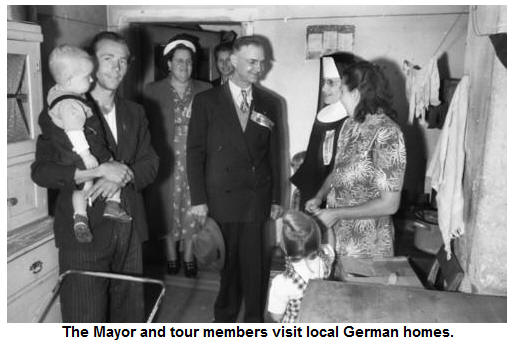
Then, the
story goes cold. Perhaps fellow Minnesotan Merle Potter and
his charity efforts consolidated the collections in the
upper Mid West, maybe with the anticipated departure of the
Military Government teams, a key part of the distribution
plan became undone and maybe - Tony Volkmuth’s German
friends simply reported that widespread aid was no longer
necessary.
December 8,
1951 Stars and Stripes reported that twenty - five citizens
from the tiny village of Ostheim, about three miles
northwest from Mellrichstadt, had opened their homes to
local American soldiers to enjoy a Christmas away from the
barracks. This message was relayed from the local Military
Government representative in Mellrichsadt, Mr. F. Bartz, to
the Bad Kissingen sub - post.
And finally,
December 16, 1951, Stars and Stripes - The 2nd Battalion of
the14th Armored Reconnaissance Battalion stationed at Bad
Kissingen announced that they would support Christmas
activities at the German orphanage at Hausen, just south of
Fladungen, well within the Mellrichstadt zone of the
Military Government.
So what
became of these people and their good will that enjoyed such
brief a period in the spotlight?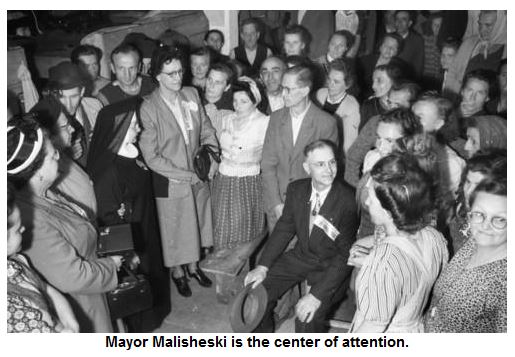
In Germany,
Lieutenant then Captain Clayton Miles Taylor had moved on
from Mellrichstadt to an assignment with the 14th Cavalry in Coburg by mid 1949 but he did return for visit when the
Project Democracy delegation passed thru in May. Later in
his career, he served in Korea as an Ordnance officer, first
as the 7th Infantry Division Materials officer and later as
an acting commander of an ordnance battalion. Stateside
assignments included work with Reserve components in
Mississippi and as a member of the Armor Board at Fort
Knox. He retired as a Major in 1960 and had a second
career as an engineer with General Dynamics at Fort Worth.
“ Bud “ Taylor died in 2009 at the age of 93.
Ellis H.
McKay left Europe and federal service in the early 1950s and
returned stateside for post graduate education. He
graduated with honors from the University of Pennsylvania
Law school and went on to clerk for Supreme Court Judge Tom
C. Clark. He spent the balance of his career as a noted
attorney in private practice.
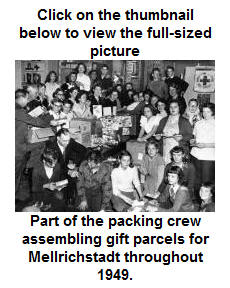 Mayor Mathew
Malisheski served only a single term as Mayor of Saint
Cloud. Brief accounts recalled his activities, he helped
start a local marching band and was instrumental in getting
a railway overpass built in the town. By 1952, he was out
of office and returned to private life and employment with
the Great Northern. He died in 1978 with the obituary in
the Saint Cloud Daily Times mentioning nothing of Project
Democracy or the Goodwill tour. In Saint Cloud today, no
one has any idea where the certificate of appreciation and
the commemorative bowl are located. Mayor Mathew
Malisheski served only a single term as Mayor of Saint
Cloud. Brief accounts recalled his activities, he helped
start a local marching band and was instrumental in getting
a railway overpass built in the town. By 1952, he was out
of office and returned to private life and employment with
the Great Northern. He died in 1978 with the obituary in
the Saint Cloud Daily Times mentioning nothing of Project
Democracy or the Goodwill tour. In Saint Cloud today, no
one has any idea where the certificate of appreciation and
the commemorative bowl are located.
Anton “ Tony
“ Volkmuth died in 1964 and as late as 2006, was still being
recalled in the Saint Cloud press as a man of significant
deeds. The Saint Cloud Times Sesquicentennial Spotlight
series recalled him as one of the 150 significant area
pioneers. The article reviewed his humble origins and how
he guided his newspaper through many different incarnations
until the Photo News was the largest weekly newspaper in
Minnesota. Eventually, he sold his newspaper, went into the
printing business and passed this on to his sons. When not
working at the print trade, Tony ran a successful tour
business featuring visits to central Germany and in 1950 -
he led a tour to Rome to visit the Pope. The final
paragraph in the modern recollection of his life recalled
his efforts in behalf of the post World War II German relief
programs.
The towns of
Saint Cloud Minnesota and Mellrichstadt are no longer sister
- cities.
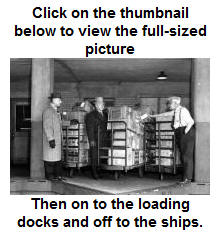
November 2012
Home |
Return to Hidden Stories
|